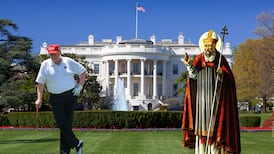The most harrowing thing about the current rash of political think-ins, love-ins, gymnastic policy positions and embarrassing photo opportunities is not so much their tedium as their almost certain irrelevancy to the day of the count.
Ostensibly, the campaign for the 2007 general election will be the longest in the history of Irish democracy, but in truth this charade will have but the most tenuous relationship to democracy, because the outcome, as likely as not, will be a combination of parties the people will have explicitly rejected at the polls. There will be nothing new about this. For nearly 20 years, governments have been nominated by the Dáil in direct contravention of the expressed wishes of the electorate.
The last administration to take office on the basis of a straightforward (if qualified) mandate was the 1987 minority government under Charles Haughey, albeit on a programme for government that was binned once the administration took office. Since then, with coalition a constant feature, none of the combinations approved by the Dáil had first received even a muted endorsement from the electorate. Two administrations - the 1992 Fianna Fáil/Labour coalition and the 1994 Rainbow Coalition - comprised combinations of parties explicitly ruled out in the 1992 general election, when Labour expressly stated that it would not coalesce with Fianna Fáil and both Fine Gael and Democratic Left said they would rather jump off different cliffs than go into government with one another.
Even in 2002, when a FF/PD administration seemed the most likely outcome, we had Michael McDowell climbing poles in an attempt to persuade people to vote tactically against Fianna Fáil. Mr McDowell was saying, in effect: "Do not vote for a single party government. You can rely on the smaller parties to horse-trade you a government." It is argued that all this is part of democracy and that the final configuration of parties after an election is willy nilly a reflection of the "will of the people". But in the way our political system is developing, such outcomes more often reflect the confusion of the electorate than any sense of its "will".
All parties nowadays operate their electoral strategies on the basis of convincing different elements of the electorate of different things, leaving the composition of government to be dictated by the post-election arithmetic, the alleged "complex intentions of the electorate" and, above all, "the public interest". But when parties send out mixed, ambiguous or just plain cute messages, different elements of the electorate are bound to respond in different ways.
For example, despite the current posturing of the Labour Party, there is a high probability that the post-election arithmetic next summer will suggest a Fianna Fáil/Labour coalition as the only viable possibility for a stable coalition partnership. And, on the basis of past experience, we can be virtually certain that, when this occurs, Labour will declare that, despite its prior objection to coalition with Fianna Fáil, the "will of the people" must not be ignored.
It is obvious to us now that most of those who will have voted for the Labour Party will have done so because of having been reassured that Labour would not, under any circumstances, coalesce with Fianna Fáil. Many will have voted Labour in order to bring about a Fine Gael/Labour coalition (which for the purposes of this argument will have attracted insufficient support). Thus, the intentions of these voters will be turned inside out in pursuit of the "hidden intention" of the electorate.
This is a roundabout way of saying something banal, although its banality has not prevented this republic being run for two decades by administrations with no true electoral mandate. There is a way of avoiding this, requiring, in effect, a second election to be run in parallel, though not necessitating a second vote. What is called for is an assessment of the votes of the electorate on the basis of this question: what is the genuine preference of the electorate in the matter of coalition partnerships? By assessing the pattern of transfers between parties, it would be easy to decide which parties the electorate really believed compatible and which were regarded as unviable or inappropriate partnerships.
The methodology might gravitate around an examination of the point in each ballot paper when the vote first moves from one party to another. For example, a voter might vote one, two, three for Fianna Fáil and then give a number four preference to the PDs. This could reasonably be interpreted as indicating a preference for an FF/PD coalition. Only if the result apparent in the overall arithmetic were in line with this secondary assessment of the votes would the relevant combination of parties be regarded as a reflection of the will of the people. Any other outcome would require a return to the country. The lawyers will claim that such a system would require a constitutional amendment. I don't believe so. But even if it did, it would be worth it to retrieve our democracy from the clutches of Labour, the Greens, the PDs and Sinn Féin.








